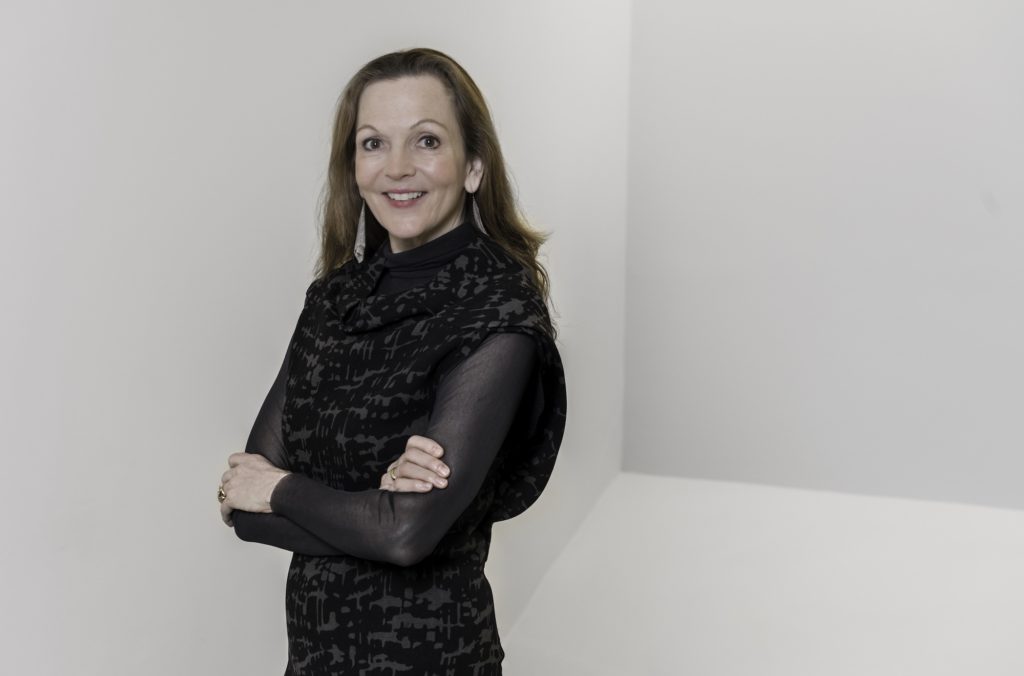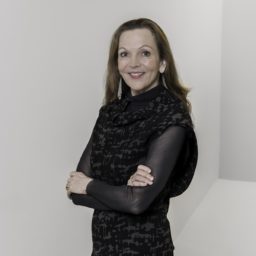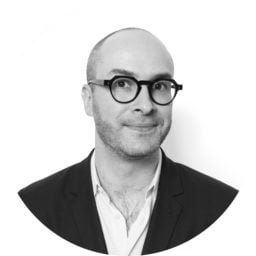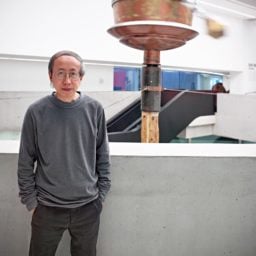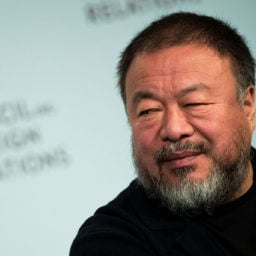For at least the past decade of her career, Alexandra Munroe, the Guggenheim curator’s senior curator of Asian art, has not only been an organizer of museum exhibitions—she has been a kind of geopolitical envoy, shuttling back and forth between the art communities in Asia and the United States to strengthen bonds and open new avenues of exchange. The responsibilities in her portfolio are impressive: she is the founding director of the Guggenheim’s Asian Art Initiative, the organizer of the museum’s biannual Asian Art Council, and the head of the Robert H. N. Ho Family Foundation Chinese Art Initiative.
Now, Munroe has marshaled her painstakingly gathered insight and connections to assemble one of her boldest exhibitions yet, “Art and China After 1989: Theater of the World.” Co-curated with Hou Hanru and Phillip Tinari, the show attempts to present an intellectual history of contemporary art in China from the two decades between the generational tragedy of Tiananmen Square and the country’s geopolitical ascent represented by the 2008 Beijing Olympics. Such a sweeping topic would pose a challenge for any curator, given the seismic degree of change experienced in China over that period, but Munroe’s ambitions do not stop there. She wants to thread this narrative into the broader story of contemporary art, realigning the axis of recent history to a new understanding that is shared between the superpowers of the West and the East.
Because of the tremendous controversy that has surrounded the show even before its opening—due to the show’s inclusion of three works that featured animals in a way that sparked widespread protest and recrimination—this fascinating larger agenda is at risk of getting lost. In part two of an interview with artnet News’s editor-in-chief Andrew Goldstein (conducted before the museum decided to remove the offending works from the show), Munroe discusses the ideas at the heart of her exhibition.
Read part one of the interview here.
As the first major show in the United States to examine this generation of Chinese conceptual artists, “Theater of the World” will introduce several artists who come off as heroes in this art-historical narrative. One of these is Gu Dexin, who the exhibition catalogue describes as “China’s most important artist.” Can you talk about him a bit? He’s not exactly a household name in America.
Well, Americans are a little ignorant. He is extremely well known in Europe. He was one of three artists from China who were selected for [curator Jean-Hubert Martin’s historic Pompidou exhibition] “Magiciens de la terre” in 1989. In that show, Gu presented thousands of pieces of common found plastic items that he had blowtorched. His parents were workers in a plastic factory in Beijing, and he grew up in a workers’ housing unit, surrounded by plastic junk, so he just took a blowtorch to all this junk and turned these everyday icons of our consumerist life into things that look like disgorged guts, or excrement, or brains, or bloodied bodies.
Gu Dexin did not get into art school, so, unlike many of the artists in our show, he’s not part of that establishment academic tradition. One of the paradoxes of the avant-garde in China is that so many of these artists do come out of the national academies of art. Nonetheless, Gu read a lot, he saw a lot, and artists in Beijing revered him because of his integrity, and because he was distrustful of everything—including this new avant-garde that was being formed and forced into the official national art galleries in China in the 1980s. He was also distrustful of the state that would crush the democracy movement and student movement in 1989 and distrustful of Deng Xiaoping’s exhortation for people to “forget about your political problems—get rich.” He just had a natural integrity and a natural skepticism, which gave him an enormous freedom.
He did a fantastic piece for Hans Ulrich Obrist’s show of Chinese art at the Battersea Power Station in 2006, which was a huge wall of thousands and thousands of apples that just rotted onsite. He also did a piece for the “Asiana” show during the 1995 Venice Biennale where he filled three glass coffins with red meat and placed them on the floor of a palazzo, and it was so noxious they had to remove the meat after just three days. Then, at Galleria Continua in Beijing in 2009, he presented the work that we’re showing as the coda for this exhibition, which, like of all of his work, is simply titled after the date that it was first shown; he doesn’t give poetic titles because he doesn’t want any interpretation, it’s just the raw facts of life.
For this piece, he takes 11 sentences—“We have killed people. We have killed men. We have killed women. We have killed old people. We have killed children. We have eaten people. We have eaten hearts. We have eaten brains. We have hit people. We have punched their eyes out. We have smashed in their faces.”—and repeats them in red characters on 35 white panels as a frieze in the gallery. It was originally presented for the 20th anniversary of Tiananmen Square, but that is not the point. The point is that these sentences can apply to any one of us. These sentences can apply to the moral failure of all of us in the 21st century; it is a simply a fact of life, not just a commentary on the moral failures of contemporary society, but of history, of humanity. It’s pretty dark, but it’s also quite factual. We also have to look at it as one of the great works of language art of our age—it’s right up there with Barbara Kruger and Lawrence Weiner. It’s very visually striking, and it’s the last piece you see in the show.
After exhibiting that piece, known as 2009-05-02, Gu Dexin famously stopped making art. What happened to him?
Today he lives with his wife in the same room that he grew up in, which has probably never been cleaned, and he spends his days swimming, reading, and talking to his friends. A lot of artists still see him. He’s one of the few who is not coming to the opening of the show—he never really went to any of his openings—but he still talks and writes.
When Duchamp announced his retirement from art to devote himself to chess, many saw that period of his life as a continuation of his “non-retinal” artistic practice—though of course we now know he continued to work on Étant donnés in secret. Is it possible to see Gu Dexin’s post-art career as an artistic statement in itself?
Well, he just grew very skeptical of the art world—he thought it had become a shadow of itself, that it had lost its integrity and become completely coerced and coopted. And not just the Chinese art world, but the international art world. He lost interest in it.
It’s a powerful form of renunciation.
It’s interesting, because Gu Dexin was also a part of the New Measurement group in Beijing in the late ‘80s with the artists Wang Luyan and Chen Shaoping, which was an artist collective responding to the bureaucratization of contemporary China at that time. They were saying, “Okay, you don’t want us to champion individualism? We’re going to construct a set of rules for making art that will technically eliminate the individual.” And they came up with a series of geometric rules—A1, A2, A3—that eliminated the possibility of any single artist having any mark of individual expression. It was very beautiful, with this enormous critique embedded into it, and then they got famous. Curators from abroad started to come and say, “We want to show you,” and they said, “Oh, no, you won’t,” and they burned all their works and they disbanded.
So Gu Dexin was a part of that. He doesn’t want to be a part of an art world. He wants to be in the world.
Another artist who emerged as one of heroes in the exhibition’s narrative is Ai Weiwei, who is also the curator of the show’s documentary-film component. You, meanwhile, have a long and significant relationship with Ai, going back to when you spearheaded the Guggenheim’s petition in 2011 to urge the Chinese government to release him after he was taken into state custody, beaten, and held for 81 days for his dissident art. Eventually the petition succeeded in getting 145,000 signatures. What kind of larger role do you feel Ai plays in “Theater of the World,” and in these two decades of Chinese history?
I think this show will help those who follow Ai Weiwei, and who know his work as an artist and activist on a global level, to understand the role he has played in the longer history of Chinese contemporary art. It’s a very significant role, and it has different periods of significance. One of those periods goes back to his decade in New York, when he was living on the Lower East Side and was very close to Xu Bing. We have a work in the show, which has since been collected by the Art Institute of Chicago, where he and Xu Bing find a group of paintings in the trash heap on the Lower East Side and they invent a name for this artist, and they then take a prominent American critic’s writing about another prominent American artist and translate it and publish it in a Chinese art magazine, but they gave the critic a fake name and made the article about their fake artist. So even then, in New York in the early ‘80s, they’re just already critiquing the mechanisms of the art world, specifically China’s outsize adoration of any imprimatur coming from outside the country.
These artists are in the space in between—they don’t trust anybody, and that space of distrust is a space of creativity, of questioning, and of critique. It also lends them an intellectual consciousness of deep individualism that gives them the fearlessness to make the pokes they are making. So that’s one period where Ai Weiwei’s presence is very important.
Then, of course, he comes back to Beijing in 1993, and he and Xu Bing start a journal. This was in the immediate aftermath of Tiananmen, when there was no infrastructure for contemporary art in China. The state had completely reversed its stance on any kind of acceptance or promotion of contemporary Chinese art. There was no real market at this time, but there were artists who were responding and who were already thinking of themselves as global citizens. There just wasn’t really a sense of community yet.
With this magazine, they created a sort of exhibition space on paper. But much more importantly than that, Weiwei said, “I don’t want pictures of your finished art—I want your ideas.” It really gave these artists the confidence to make thinking an act of art. In the first issue of this journal, the Black Cover Book, which is featured prominently in the exhibition, they have an extended interview with Tehching Hsieh—whom they had known as a Taiwanese artist in New York’s ‘80s downtown scene—introducing him to the Chinese art world for more or less the first time.
What kind of community formed out of this project?
It opens up what becomes the primary practice for the so-called East Village artists in Beijing, which is durational performance. It’s as if they were saying, “You can tell me where I have to live, you can tell me what I have to do, and you can kill me—but until you kill me, I own my own body, and you can’t own my body, and you can’t really own my head.” So, when Zhang Huan goes to sit in a latrine and pours honey over himself and lets the filth and the flies crawl all over him for an hour, there’s a sense of the body as a site of resistance to all these ideologies that are being formed around them—political, economic, and social.
Weiwei is a strong encourager and kind of godfather of this community right through about 2000, when he curates the exhibition “Fuck Off” that includes many of these artists as a kind of counterpoint to the 2000 Shanghai Biennial, which is the first time since 1989 that the government says, “Okay, we’re going to introduce contemporary art from China and internationally again as a kind of soft-power tool.” So, for this eight-year period, Ai Weiwei is an extremely important mentor and enabler to a lot of these artists.
Then in 2007 things begin to shift again, and when Weiwei comes out in early 2008 against the Olympics and vows in a Guardian interview not to enter the stadium that he had helped design with Herzog and de Meuron. His position as a dissident begins to set him apart from the community he had been so much a part of. His interests begin to go way beyond those of the artists in that community, and the aftermath of that is something of a rupture. It’s possible that this exhibition will help Weiwei come to peace with that rupture.
You mentioned that China withdrew official support from contemporary art after the 1987 show, but then reversed course again in 2000 with the Shanghai Biennial. I suppose this was the tail end of the Bill Clinton era, when the idea of geopolitical soft power was in vogue, but was there a more specific reason for it?
I think the fact that China entered the World Trade Organization around 2000 had something to do with it. They already were very eager to be the site of the Olympics. So they realized, very wisely, that they needed to embrace their artists and re-engage with the reforms that had guided some of their policies in the 1980s. Also, Harald Szeemann had deliberately included 20 Chinese artists in his 1999 Venice Biennale, which is when Cai Guo-Qiang wins the Golden Lion award. There was a lot going on in China, combined with a tremendous confidence in their economic growth and a greater sense of the need to integrate culture and a greater understanding of the economic benefit of culture.
What was it that made Ai Weiwei turn on his own creation and begin to see the Olympics as pure propaganda, as something he no longer wanted to have a part in?
I think you have to ask Ai Weiwei that. I think the situation was obvious to many artists, but Ai Weiwei was the only one who dared to say it. The Olympics were an occasion for the Chinese state to position itself as a global superpower. It had arrived at a point where it was the second-largest economy in the world, but in order to maintain a certain sense of ease it required quite a strong hand on the part of the Chinese government to keep troubles from erupting. One of those troubles was, frankly, the potential for certain ethnic groups, including the very large Muslim minority in the far Western part of China, from erupting into Islamic fundamentalism.
There was also some concern about the uses of social media, which had just come online around 2007, and it took China until around this time to figure out how to censor the internet—something Weiwei talks a lot about. It took the Chinese government a while to figure out how to impose the structures that they now have to prevent that kind of mobilization. But, you know, what also happened in 2008 that really hardened this position of dissidence for Weiwei was the Sichuan earthquake that May. The Olympics were opening four months later, so this was a huge embarrassment for the government, as well.
Everyone knows what happens next: Ai Weiwei’s increasing dissident activities become internationally renowned and the Chinese government cracks down harder and harder, culminating in his arrest and beating in 2008. In the show’s catalogue there’s an extraordinary self-portrait that Ai took in the mirror of an elevator while being taken away by a police officer and immediately posted to Twitter. The camera’s flash illuminates the artist’s defiant expression, the annoyed look of the officer, seen in the mirror, and the spooked face of a hapless-appearing third passenger. It was a masterstroke of Ai’s use of social media as a means of dissent, something that would become his trademark. Now, even after he was allowed to leave China and resume his physical place on the international stage, his dissident position is as famous—if not more famous—than his art. In the catalogue, you quote him as saying, “I think my stance and my way of life is my most important art.” Do you agree with that?
Well, I think a lot of artists feel that way. That is the legacy of Duchamp, that our act of thinking can be the same as art. There’s no difference between making art and living. One reason why we are using this year of 1989 as the starting point for the show is that it’s similar to what 1968 represents for American and European artists: the year of protest that left a generation of artists and intellectuals, filmmakers, radicals in a state of questioning and doubt. It’s from this state of doubt that so much of late conceptual art, post-minimal art, and performance art evolves. It’s a new sense that we cannot merely seek to be heroes and recluses in our studio—that we have to act in life. We have to be part of a social fabric.
It’s more than just breaking down the division between art and everyday life. It’s breaking down the division between art and society. And I think Chinese artists have a specific relationship to that concept because of the legacy of communism, where you’re taught that art and society are one and the same, and that anything that is uselessly aestheticized needs to be eliminated. It is an art of realism.
This way of thinking begins to resonate with another artistic development that is going on in the world in the 1990s, which is relational aesthetics, another move—coming from a very different set of positions—to take art out of the hallowed halls of high conceptualism and push it into the streets and the lives of people again. That’s what was behind the resurgence of performance art. These different attitudes are evolving around the same time, and it’s one reason why we argue it’s so important to integrate the work of Chinese artists—be they working in China or Paris, New York, or Tokyo—into our understanding of this two-decade period. They were inter-connected.
Obviously, there is a lot of work in “Theater of the World” that would not be shown in China, given its political content. What was your relationship and engagement with the Chinese government in putting together this show. Have they smiled on your effort?
We had very important relationships with the academies of art, which are under the direct charge of the ministry of education. We had our first advisory committee meeting with our counterparts in Hangzhou under the auspices of the curatorial studies program at the China Academy of Art there. Many of our artists live and work in Hangzhou and teach at that academy. We fully discussed the ideas of this exhibition, including its title, over four days. The protagonists of this story were all in that room, including Gao Minglu.
Then we had a second advisory committee meeting in March of this year under the auspices of the Central Academy of Fine Arts in Beijing, and Fan Di’an, the president of the academy, presided over this four-day conference, and Wang Hui, the great historian of Tsinghua University, was our keynote speaker. They said, “You know, you’re fine. We’re so happy to invite you here under our auspices, but let’s just call it ‘Theater of the World’ in the posters around campus [dropping the ‘Art and China After 1989’] and you can do whatever you want behind closed doors.” So the posters around campus said “Theater of the World,” and we carried on.
In other words, the academies have been extremely important. I’m not going to say whether or not they gave their blessing, but many of the artists are prominent teachers. This is not a show that is taking any political stance about China. This is a show about how much we need to wake up to the importance of this period of art. There are many positions represented here, and some artists are extremely nuanced about their conditions, and some artists are quite political, and some artists aren’t at all. I think it would be a mistake to over-politicize this show, because it’s much more nuanced than that. And the artists are a lot smarter than that.
I think that is an important point—that this is not a show about artists who are stuck living under some kind of totalitarian regime, but about artists who are citizens of the world.
Thirty percent of our artists have lived and worked abroad, and about 50 percent of the works on view are deliberately works that were made for international projects, including documenta, “Magiciens de la terre,” and various iterations of the Venice Biennale. This is not a show about identity politics. This is a show about a group of artists who were working internationally, and who happened to share a link to a hugely important country that has seen more change than any other single country in history.
You don’t have to be an expert on China to understand this show, and I don’t want you to leave as an expert on China. I want you to leave as someone who is more aware of the complicated stakes of being a member of this world today with a country like China present. There are realities at work here that we, as privileged Americans living in our own highly sophisticated art world, have not had the occasion to contemplate.
Speaking of our highly sophisticated art world in America, art has become renown in broader American culture as an expression of cutting-edge sophistication and wealth, something that celebrities want to collect—the ultimate luxury good. What role does contemporary art play in the larger culture in China?
Well, contemporary art is only one aspect of a huge cultural industry in China. We have to remember, ink art and calligraphy are still by far the dominant genres of art, and the contemporary art market in China is dominated ink artists. There are also many other forms of contemporary art in China that are rooted in certain traditional craft arts, like paper-cutting. And these other forms of art are very robustly represented in the academies alongside artists working on VR projects and with other new media. It’s instructive to look at the curricula of the art schools there, because it’s much broader than we think.
Within the fabric of China, Hong Kong, and Taiwan, contemporary art is minor. But it’s increasingly linked to the creative industry. Art, digital innovation, fashion, and architecture are much more integrated in China than they are here. You don’t have the same hierarchy that’s so embedded in America and Europe about art versus architecture versus tech. And the project of being a “Chinese artist” is no longer first and foremost on their minds. Contemporary art is now taught in the schools, there’s a market for it—and it’s a hot, international market. The UCCA [Ullens Center for Contemporary Art] has close to a million visitors a year.
There isn’t a sense that we’re studying Chinese art as this specimen anymore. The doors have opened.
